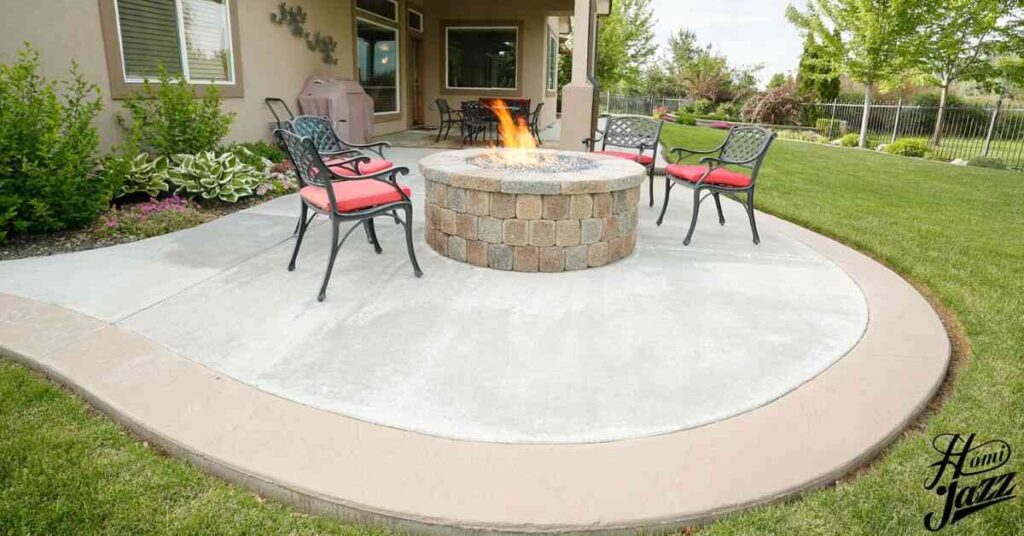Installing a concrete patio involves significant investment of time, money and effort. Many homeowners face challenges with cracking, uneven surfaces, or poor drainage due to incorrect installation. These issues often lead to costly repairs and reduced property value. A properly installed concrete patio can last decades while enhancing your outdoor living space. This comprehensive guide provides detailed instructions for successful concrete patio installation. From site preparation and material selection to pouring techniques and finishing touches, you’ll learn the essential steps and professional tips to create a durable, attractive patio that adds lasting value to your home.
Understanding Concrete Patios
A concrete patio is an outdoor living space made from poured concrete. The concrete patio installation process transforms a basic backyard into a functional area for relaxation and entertainment. Modern concrete patios come in various designs and can support heavy outdoor furniture, grills, and other features without damage.
What is a Concrete Patio?
Concrete patios are solid outdoor surfaces created by pouring and hardening concrete mixture. During concrete patio installation, the concrete is poured into prepared forms and finished to create a durable surface. These patios typically range from 4 to 6 inches thick and can be customized to match any home’s style.
In 2024, concrete remains one of the most popular choices for outdoor spaces due to its durability and versatility.
Types of Concrete Patios
The concrete patio installation process offers several design options. Stamped concrete mimics natural stone or brick patterns. Stained concrete adds color and visual interest. Polished concrete provides a modern, sleek finish.
Exposed aggregate reveals decorative stones in the surface. Broom-finished concrete offers a simple, non-slip texture. Each type requires specific installation techniques and finishing methods.
Benefits and Drawbacks of Concrete Patios
The main benefits of concrete patio installation include durability, low maintenance, and design flexibility. Concrete patios can last 25-30 years with proper care. They resist weather damage and don’t require frequent repairs.
However, concrete can crack in extreme temperatures. It may stain from leaves or spills. Repairs often remain visible. Professional installation helps minimize these issues through proper reinforcement and sealing techniques.
Pre-Installation Planning
Successful concrete patio installation begins with careful planning. This includes measuring the space, checking local building codes, and obtaining necessary permits. The planning phase typically takes 1-2 weeks. Consider drainage patterns, sun exposure, and access to utilities. A detailed plan prevents costly mistakes and ensures compliance with local regulations.
Site Assessment and Design
Site assessment involves evaluating ground slope, soil type, and drainage patterns. The concrete patio installation location should have proper drainage to prevent water pooling. Measure the area and mark utilities.
Consider the patio’s relationship to existing structures and landscaping. Create a detailed design that includes dimensions, elevation changes, and features like steps or built-in planters.
Required Tools and Materials
Basic concrete patio installation tools include:
- Shovels and rakes
- Wheelbarrow
- Level and string lines
- Concrete forms
- Reinforcement mesh
- Concrete mix
- Finishing tools Materials needed:
- Gravel for base
- Concrete (calculate cubic yards)
- Form lumber
- Stakes and screws Always purchase 10% extra materials for unexpected needs.
Cost Considerations
In 2024, concrete patio installation costs range from $6 to $16 per square foot. A basic 12×14 foot patio typically costs $2,000-$3,500. Factors affecting price include:
- Size and thickness
- Design complexity
- Local labor rates
- Material costs
- Site preparation needs DIY installation saves on labor but requires proper tools and experience.
Site Preparation Process
Proper site preparation is crucial for concrete patio installation success. Start by removing all grass, weeds, and organic material from the area. Mark utility lines and ensure they’re protected. In 2024, professionals recommend allowing 1-2 full days for site preparation. The ground must be completely clean and stable before proceeding with any concrete work.
Ground Preparation
The first step in concrete patio installation involves preparing the ground properly. Remove all grass and topsoil to a depth of 6-8 inches. Compact the soil using a plate compactor or hand tamper. Add a 4-inch layer of gravel base material. This creates a stable foundation that prevents future settling and cracking. Water and compact the gravel thoroughly.
Excavation Guidelines
Excavation depth for a concrete patio installation depends on your climate and soil type. In cold regions, dig at least 8 inches deep to prevent frost heave. For warmer climates, 6 inches is usually sufficient. Slope the excavation away from buildings at 1/4 inch per foot for proper drainage. Remove all loose soil and organic matter from the excavated area.
Drainage Planning
Good drainage prevents water damage during concrete patio installation and beyond. Install drain pipes if needed. Slope the sub-base away from buildings. Create a gravel layer for water drainage. Consider installing perimeter drains for areas with poor natural drainage. Plan for water runoff direction before pouring concrete. This prevents future water pooling and foundation issues.
Form Construction
Forms create the outline for concrete patio installation. Use straight 2×4 or 2×6 lumber for forms. Coat form boards with release agent to prevent sticking. Install stakes every 2-3 feet for support. Forms must be sturdy enough to hold wet concrete without bowing or moving. Check local building codes for specific form requirements.
Building the Forms
Start form building by marking the patio perimeter. Install stakes at corners and every 2-3 feet along the edges. Attach form boards to stakes using screws. During concrete patio installation, forms must be level and secure. Use straight, undamaged lumber. Make sure all joints are tight and well-supported to prevent concrete leakage.
Form Leveling and Squaring
Proper leveling ensures successful concrete patio installation. Use a laser level or string level to check form height. Square corners using the 3-4-5 method. Measure diagonally to confirm square corners. Adjust forms until perfectly level and square. Double-check measurements before securing forms firmly. This attention to detail prevents problems during concrete pouring.
Reinforcement Installation
Install reinforcement for stronger concrete patio installation. Use 1/2-inch rebar in a grid pattern, spaced 2 feet apart. Add wire mesh for additional strength. Support reinforcement on chairs or blocks to keep it centered in the concrete. Overlap mesh sheets by 6 inches. Tie reinforcement securely to prevent movement during concrete pouring. This step significantly reduces cracking risks.
Concrete Preparation and Pouring
Proper concrete patio installation requires careful preparation of the concrete mix. The concrete must have the right consistency – like thick oatmeal. In 2024, most homeowners choose ready-mix concrete delivery for larger patios. Small projects under 80 square feet can use bagged concrete mix. The temperature should be between 50-90°F for optimal pouring conditions. Always have enough workers ready before the concrete arrives.
Calculating Concrete Quantity
For accurate concrete patio installation planning, calculate the volume needed. Multiply length x width x depth (in feet) and divide by 27 to get cubic yards. For a 12×14 foot patio that’s 4 inches thick, you’ll need about 1.7 cubic yards. Add 10% extra for waste. A single cubic yard covers about 80 square feet at 4 inches thick. This calculation ensures you order enough concrete for the project.
Mixing Concrete
For small concrete patio installation projects, mix concrete in a portable mixer. Use 1 part cement, 2 parts sand, and 3 parts gravel. Add water slowly until reaching proper consistency. Test by making a cone shape – it should stand 2-3 inches high without slumping. In 2024, fiber reinforcement additives improve strength. Never mix more than you can pour in 30 minutes.
Pouring Techniques
Start concrete patio installation pouring from one corner, working systematically across the space. Pour in even layers about 2 inches deep. Use a straight board to push excess concrete forward. Keep a consistent pour rate to prevent cold joints. Concrete should fill forms completely without gaps. Work quickly but carefully – concrete begins setting within 30-60 minutes.
Finishing Process
After pouring, concrete patio installation enters the finishing phase. Wait until water sheen disappears from surface. Use a wood float to level high spots and fill low areas. Work systematically in overlapping passes. Don’t overwork the surface – this brings too much water up. The timing of finishing steps depends on weather conditions and concrete mix.
Initial Smoothing
The first step in concrete patio installation finishing uses a bull float. This large flat tool smooths and levels the surface. Push forward with the leading edge slightly raised. Pull back with the trailing edge raised. Work entire surface until level. Don’t smooth too early – wait until bleed water disappears. This usually takes 15-30 minutes after pouring.
Adding Texture
Texture during concrete patio installation provides slip resistance and visual appeal. Use a broom finish by dragging a special concrete broom across partially hardened surface. Make straight, consistent strokes. Other options include swirl patterns or stamped textures. Apply texture when concrete is firm enough to hold pattern but still workable. Timing is crucial for good results.
Edge Treatment
The final step in concrete patio installation involves edging. Use an edging tool to create smooth, rounded edges. This prevents chipping and creates a finished look. Work when concrete is still plastic but firm enough to hold shape. Make two passes – first to form edge, second to smooth. Proper edging improves durability and appearance.
Understanding Concrete Patios
A concrete patio creates a solid foundation for outdoor living. The concrete patio installation process has evolved significantly since 2020, making it more accessible for homeowners. These outdoor spaces serve multiple purposes, from casual dining areas to elaborate entertainment zones. A well-built concrete patio connects your indoor and outdoor spaces while adding significant value to your property. The surface withstands daily use and various weather conditions, making it a practical choice for any home.
What is a Concrete Patio?
A concrete patio forms a flat, sturdy outdoor surface made from cement, sand, and aggregates. The concrete patio installation requires careful preparation and proper mixing of these materials. Unlike wooden decks, concrete creates a seamless surface that needs minimal upkeep. Most concrete patios last 20-30 years when installed correctly. The finished surface provides a stable base for outdoor furniture, grills, and other features while maintaining its appearance over time.
Read This Blog: Nate Bargatze House: A Humble Abode Reflecting the Comedian’s Down-to-Earth Charm
Types of Concrete Patios
Modern concrete patio installation offers numerous style options. Basic concrete provides a clean, simple look. Stamped patterns create texture and visual interest. Stained concrete adds color and character. Each type suits different home styles and budgets. Recent advances in concrete technology have introduced new finishes and textures. Homeowners can now choose from options that mimic natural stone, brick, or tile at a fraction of the cost.
Benefits and Drawbacks of Concrete Patios
The concrete patio installation brings clear advantages and some limitations. Benefits include exceptional durability, minimal maintenance, and design flexibility. These patios handle heavy foot traffic and resist weather damage. However, concrete can develop cracks in extreme temperatures. Surface stains might need professional cleaning. Repairs sometimes show visible patches. Installation timing affects the final result, with spring and fall offering ideal conditions.
Pre-Installation Planning
Smart planning makes concrete patio installation smoother. Start by checking local building codes and getting permits. Measure your space carefully and plan for drainage. Consider sun patterns and how you’ll use the space. Make a detailed timeline that includes curing time. Plan around weather forecasts to avoid rain during installation. Good preparation prevents common problems and ensures better results.
Also Read This Blog: Inside Luke Combs House: A Country Star’s Nashville Haven
Site Assessment and Design
Proper concrete patio installation starts with thorough site evaluation. Check ground slope and soil type. Mark utility lines and plan drainage paths. Consider existing trees and structures. Draw a detailed plan showing dimensions and features. Include space for expansion joints and decorative elements. Record sun patterns and shade areas. This assessment helps create a patio that works well with your property.
Common Problems and Solutions
Concrete patio installation often faces common issues like cracking, uneven surfaces, and poor drainage. Modern installation techniques in 2024 help prevent these problems through proper base preparation and reinforcement. Weather conditions during installation greatly affect the final result. Most problems occur from rushed work or skipping essential steps. Good planning and attention to detail prevent most common issues.
Installation Challenges
The biggest concrete patio installation challenges include weather timing, proper concrete mixing, and achieving a level surface. Too much water in the mix leads to weak concrete. Cold weather slows curing. Hot weather causes rapid drying. Poor soil compaction creates future settling problems. Each challenge requires specific solutions and careful attention during installation.
Troubleshooting Guide
Common concrete patio installation problems have specific solutions. Fix small cracks with epoxy filler. Level uneven areas during finishing. Address drainage issues by adjusting slope. Control joint spacing prevents random cracking. Surface imperfections need immediate attention during installation. Quick response to problems prevents larger issues later.
When to Call a Professional
Professional help is needed when concrete patio installation involves complex designs or large areas. Signs to call experts include:
- Severe ground slopes
- Poor soil conditions
- Complex drainage needs
- Custom design features Professionals have specialized tools and experience for challenging installations.
Enhancing Your Concrete Patio
After concrete patio installation, many enhancement options exist. Current 2024 trends include built-in seating, fire pits, and outdoor kitchens. Lighting adds safety and ambiance. Weather-resistant finishes protect the surface. Each enhancement should complement the original design while adding functionality.
Decorative Options
Decorative concrete patio installation features include:
- Colored concrete
- Stamped patterns
- Stenciled designs
- Border details These options add visual interest without compromising durability. Modern techniques create realistic stone and brick appearances. Most decorative work happens during installation.
Additional Features
Popular concrete patio installation add-ons include:
- Built-in planters
- Step lighting
- Pergola posts
- Drainage channels These features enhance functionality and appearance. Plan for additions during initial installation for best results. Each feature needs proper anchoring in the concrete.
Landscape Integration
Successful concrete patio installation includes blending with existing landscaping. Plant beds soften edges. Ground cover prevents soil erosion. Proper grading ensures good drainage. Strategic plantings provide privacy and shade. The patio should look natural in its setting, not like an afterthought.
Frequently Asked Questions
How do you put in a concrete patio?
- Clear and level the area
- Dig to proper depth
- Add gravel base
- Install forms and reinforcement
- Pour concrete
- Level and smooth surface
- Add texture finish
- Allow proper curing time
What is patio concrete?
Patio concrete is a special mix designed for outdoor use. It’s stronger than regular concrete and contains:
- Portland cement
- Sand
- Gravel
- Special additives for outdoor durability
- Water-resistant properties
- Extra strength for heavy furniture
Is it expensive to pour a concrete patio?
Current costs in 2024:
- Basic patio: $6-16 per square foot
- Average 12×14 foot patio: $2,000-$3,500
- DIY savings: About 40-50%
- Professional installation adds $2-5 per square foot
- Decorative finishes increase cost by 20-30%
How deep should concrete be for a patio?
Standard depths:
- Minimum thickness: 4 inches
- Regular use: 4-5 inches
- Heavy furniture: 5-6 inches
- Cold climates: 6 inches
- Vehicle parking: 6-8 inches
What are 3 ways concrete can be placed?
- Direct Pour Method
- Straight from truck
- Best for easy access areas
- Most common method
- Pump Truck Method
- Uses long boom arm
- Good for hard-to-reach areas
- More expensive option
- Wheelbarrow Method
- Manual transport
- Best for small jobs
- Good for tight spaces
Do you need a foundation for concrete patio?
Yes, a proper foundation is essential:
- Remove topsoil and grass
- Add 4-6 inches of gravel base
- Compact soil properly
- Install proper drainage
- Level surface before pouring
- Add reinforcement mesh or rebar
Conclusion
Building a concrete patio can transform your outdoor space into a beautiful, lasting addition to your home. With proper planning and the right techniques, you can create a durable surface that serves your family for decades. Remember that good preparation, correct depth, and proper curing are key to success. Whether you choose DIY or professional help, focus on quality materials and careful installation for the best results.

Howdy is behind this home blog, sharing personal stories, thoughts, and insights from daily life. I can dedicated to bringing you the latest trends, expert advice, and creative ideas to make your home the sanctuary you’ve always dreamed of. Whether you’re looking for DIY tips, home decor inspiration, home loans, rentals or renovations.







